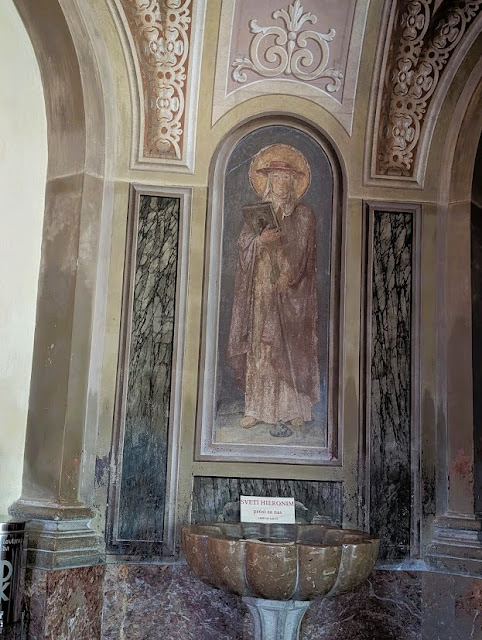There comes a time on every long trip when we tire of moving around every few days. It used to take months before that happened, but this time it came after we had time in only two countries. Plus, we both have fierce head and chest colds. So we are not giving Slovenia its due.
The map below shows our original plans, and the red line through a place means we didn't go there. The green circles indicate places we did get to, or will soon be heading to. In a way, it's sad, but on the other hand, we are happy with the decision to slow down. We are giving ourselves a treat of twelve days in a seaside town on the Adriatic Sea, followed by just a few more days of travel, then home.
So, now we are in Postojna, and we basically spend it in bed, trying to recover from this illness. We have no energy to do anything and don't want to expose others to our cold germs, so we lie low.
The reason people come here is to see the famous Postojna caves and castle. There's not much else here.
After this, we will be heading to the seaside.
The journey to get here was pretty weird. We had to go from Bohinsjka Bistrica back down to Ljubljana by bus, then transfer to the bus that would take us to Postojna. The first part of the journey went fine. Once we got to Ljubljana we could not believe the traffic. I guess we are insulated from this by mostly staying in Old Towns that are usually pedestrian only, or taking city buses away from the center. And when someone else is driving like bus or train, traffic is really not an issue.
Traffic was backed up for miles and miles. Our bus driver appears to have made the decision to leave the main highway and take back roads to Postojna. The trouble is, he doesn't know the rural roads and gets lost. Twice. He stops a bus and a big truck to hop out and ask for directions. The traffic is pretty heavy on the back roads, too. The supposed 70-minute journey took two and a half hours; however, I think he did get us there sooner than if he had stayed on the main highway.
We spoke to another driver about it, and he told a similar story to what we heard in Romania. He felt that when the communists were in power, they invested a lot in infrastructure. They have been out of power now for forty years, and there's a belief that no money has been spent on roads and other kinds of infrastructure since.
It's recognized that some sort of settlement existed in Paleolithic times, where Postojna now stands. As a town, it was first referred to in the 13th century. It became a borough in 1432, and a town in 1909.
The Tourist Info Center has a booklet called "Follow the Town Trail", so we did this on our last day there. Below is an assortment of highlights from that 'trail', which we tried to capture:
We were sent to the lovely little Church of St. Lazarus.
What the town wanted us to see was the tomb of Fran Jurca's Family, a wealthy and important family in the development of the town. One has to make prior arrangements to get inside the tomb, which, according to the booklet, has a ceiling painting of the Virgin Mary with a dead Jesus, as well as full-body sculptures of Mr. Jurca's wife and son. In 2006 the Municipality of Postojna restored the tomb in consultation with historians and the family heirs. The restoration was completed in 2016.
There were other impressive tombs near the one of the Jurca family. The one below intrigued us the most. Was this for a firefighter, a miner, logger?
The building below was built in 1900 and is known as the Miroslav Vilhar Primary School. This man who was a Slovenian composer, poet, playwright, politician and publisher of a political newspaper, advocated for the rights of Slovenians during the Austro-Hungarian Empire rule.
The twin towers of the Church of St. Stephen (built 1777) are seen from most places in town. St. Stephen was the patron saint of horses. This pays homage to the economic importance of Draught horses in the area when transportation by horse-drawn carts was the norm.
Just a few photos from the inside of the church.
Between 1950 and the late 1980's a new maternity hospital was being built, so women gave birth in the building below. No visitors were allowed in, so friends and relatives would stand on the road above the building to wave to the new moms standing in the windows with their newborns.
The booklet had twenty-six stops of interest, but the ones above were the most interesting to us.
We are excited to be going to the Slovenian Istria peninsula, and our seaside vacation.















No comments:
Post a Comment